|
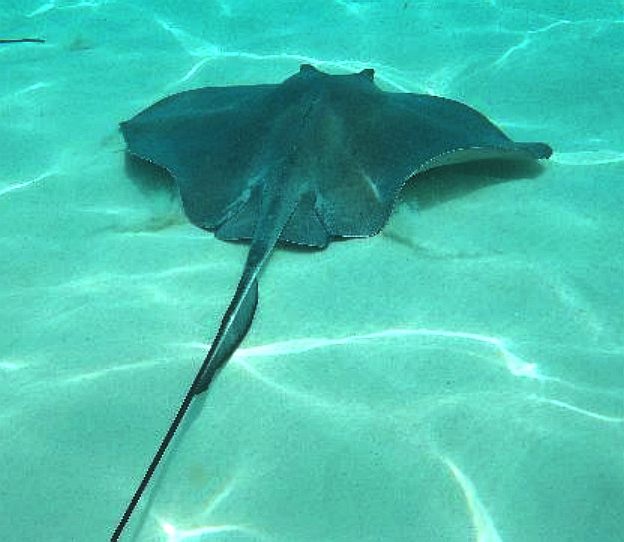
Stingrays are a group of rays, which are cartilaginous fishes related to
sharks. They are classified in the suborder Myliobatoidei of the order Myliobatiformes, and consist of eight families: Hexatrygonidae (sixgill stingray), Plesiobatidae (deep water stingray), Urolophidae (stingarees), Urotrygonidae (round rays), Dasyatidae (whiptail stingrays), Potamotrygonidae (river stingrays), Gymnuridae (butterfly rays), and Myliobatidae (eagle rays).
Most stingrays have one or more barbed stings (modified from dermal denticles) on the tail, which are used exclusively in self-defense. The stinger may reach a length of approximately 35 cm (14 in), and its underside has two grooves with venom glands. The stinger is covered with a thin layer of skin, the integumentary sheath, in which the venom is concentrated. A few members of the suborder, such as the manta rays and the porcupine ray, do not have stingers.
Stingrays are common in coastal tropical and subtropical marine waters throughout the world, and also includes species found in warmer temperate
oceans, such as Dasyatis thetidis, and those found in the deep ocean, such as Plesiobatis daviesi. The river stingrays, and a number of whiptail stingrays (such as the Niger stingray), are restricted to fresh water. Most myliobatoids are demersal, but some, such as the pelagic stingray and the eagle rays, are pelagic.
While most stingrays are relatively widespread and not currently threatened, for several species (for example Taeniura meyeni, D. colarensis, D. garouaensis, and D. laosensis), the conservation status is more problematic, leading to them being listed as vulnerable or endangered by IUCN. The status of several other species are poorly known, leading to them being listed as Data Deficient.
ECOTOURISM
Stingrays are usually very docile and curious, their usual reaction being to flee any disturbance, but they will sometimes brush their fins past any new object they encounter. Nevertheless, certain larger species may be more aggressive and should be approached with caution, as the stingray's defensive reflex (use of its poisoned stinger) may result in serious injury or death.
Dasyatids are not normally visible to swimmers, but divers and snorkelers may find them in shallow, sandy waters, more so when the water is warm. In the Cayman Islands several dive sites called Stingray City, Grand Cayman, allow divers and snorkelers to swim with large southern stingrays (D. americana) and feed them by hand. A "Stingray City" in the sea surrounding the
Caribbean island of Antigua consists of a large, shallow reserve where the rays live, and snorkeling is possible, since the rays are used to the presence of
humans.
In Belize, off the island of Ambergris Caye, there is a popular marine sanctuary, Hol Chan, where divers and snorkelers often gather to watch stingrays and nurse sharks drawn to the area by tour operators who feed the animals.
Many Tahitian island resorts regularly offer guests the chance to "feed the stingrays and sharks". This consists of taking a boat to the outer lagoon reefs, then standing in waist-high water while habituated stingrays swarm around, pressing right up against tourists seeking food from their hands or that being tossed into the water. The boat owners also "call in" sharks, which, when they arrive from the ocean, swoop through the shallow water above the reef and snatch food offered to them.
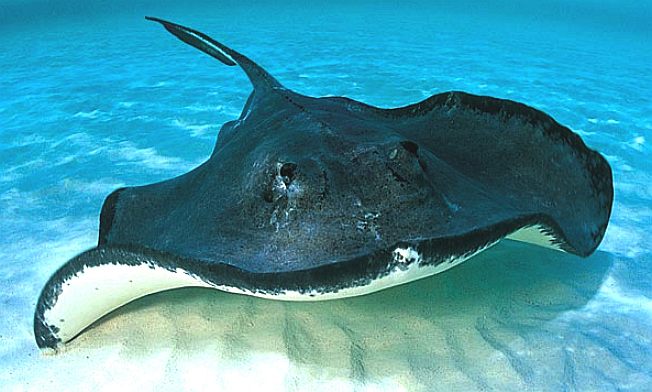
BEHAVIOUR
The flattened bodies of stingrays allow them to effectively conceal themselves in their environment. Stingrays do this by agitating the sand and hiding beneath it. Because their eyes are on top of their bodies and their mouths on the undersides, stingrays cannot see their prey; instead, they use smell and electroreceptors (ampullae of Lorenzini) similar to those of sharks. Stingrays feed primarily on molluscs, crustaceans, and occasionally on small fish. Some stingrays' mouths contain two powerful, shell-crushing plates, while other species only have sucking mouthparts. Stingrays settle on the bottom while feeding, often leaving only their eyes and tail visible. Coral reefs are favorite feeding grounds and are usually shared with sharks during high tide.
REPRODUCTION
When a male is courting a female, he will follow her closely, biting at her pectoral disc. He then places one of his two claspers into her valve.
Stingrays are ovoviviparous, bearing live young in "litters" of five to 13. The female holds the embryos in the womb without a placenta. Instead, the embryos absorb nutrients from a yolk sac, and after the sac is depleted, the mother provides uterine "milk".
At the Sea Life London Aquarium, two female stingrays have delivered seven baby stingrays, although the mothers have not been near a male for two years. "Rays have been known to store sperm and not give birth until they decide the timing is right".
THE
STING
Stingray injuries are caused by the venomous tail spines or stingers of rays in the order Myliobatiformes, most significantly those belonging to the families Dasyatidae, Urotrygonidae, Urolophidae, and Potamotrygonidae. Stingrays generally do not attack aggressively or even actively defend themselves. When threatened, their primary reaction is to swim away. However, when attacked by predators or stepped on, the stinger in their tail is whipped up. This is normally ineffective against sharks, their main predator.
Depending on the size of the stingray, humans are usually stung in the lower limb region. Stings usually occur when swimmers or divers accidentally step on a stingray, but a human is less likely to be stung by simply brushing against the stinger. Surfers and those who enter waters with large populations of stingrays have learned to slide their feet through the sand rather than taking steps, as the rays detect this and swim away, as will stamping on the bottom as one treads through murky water.
The stinger usually breaks off in the wound. This is not fatal to the stingray as it will be regrown at a rate of about 1.25 to 2 centimetres (0.49 to 0.79 in) per month (though with significant variations depending on the size of the stingray and the exact species). Contact with the stinger causes local trauma (from the cut itself), pain, swelling, and muscle cramps from the venom, and possible later infection from bacteria or fungi. Immediate injuries to humans include, but are not limited to: poisoning, punctures, severed arteries and veins, and occasionally death. Fatal stings are very rare, but can happen, famously including Steve Irwin. In this case, the stinger penetrated the thoracic wall, causing massive trauma.
Many victims of stingray related injuries suffer from physical effects including nausea, vomiting, diarrhea, extreme pain at the wound, muscle cramps, and a laceration at the puncture site. There have been cases of severe consequences which may include embedded spines, infection, hypotension, and even possible amputations or death. Stingray wounds have also been found to bleed profusely and for a long amount of time after the initial puncture. It has been suggested that there may be some sort of anti-hemoglobin agent incorporated with the secreted venom, but James H. Diaz, Professor at the School of Public Health has refuted that theory.
TREATMENT
Treatment for stings may include application of hot water (optimum temperature is 45 °C (113 °F), taking care not to cause burns), which can help ease pain by denaturing the complex venom protein. Antibiotics may be administered to prevent infection if there is a delay in treatment, if the wound is deep, or if there is a large amount of foreign material in the wound. Immediate injection of a local anesthetic in and around the wound, or a regional nerve blockade, can be helpful, as can the use of parenteral opiates such as intramuscular pethidine. Local anesthetic may bring almost instant relief for several hours. Vinegar and papain are ineffective. Pain normally lasts up to 48 hours, but is most severe in the first 30–60 minutes and may be accompanied by nausea, fatigue, spreading cramps, headaches, fever, and chills. All stingray injuries should be medically assessed; the wound must be thoroughly cleaned, and surgical exploration is often required to remove any barb fragments remaining in the wound. Following cleaning, an ultrasound is helpful to confirm removal of all the barb fragments. Not all remnants are radio-opaque; x-ray radiography imaging may be helpful where ultrasound is not available.
STINGRAY
SUBMARINE (TV PUPPET SERIES)
Stingray
was a British children's Supermarionation television series, created by Gerry and Sylvia Anderson and produced by AP Films for ATV and ITC Entertainment between 1964 and 1965. Its 39 half-hour episodes were originally screened on ATV in the
United Kingdom and in syndication in the
United
States. The scriptwriters included the Andersons, Alan Fennell and Dennis Spooner. Barry Gray composed the music, and Derek Meddings served as special effects director.
Stingray was the first Supermarionation production to be filmed in colour, and also the first in which the marionette puppet characters had interchangeable heads featuring a variety of expressions. It was furthermore the first British TV programme to be filmed entirely in colour. At this time American
TV networks were preparing for full-time colour broadcasting, although independent television in the UK did not commence colour transmission until November 1969. 
SUBMARINE
PLOT The
series revolved around a rather futuristic looking submarine, the design
of which was enough to capture the hearts and imagination of the
children watching
at the time. Stingray, a highly-sophisticated combat submarine built for speed and manoeuvrability, is the flag vessel of the World Aquanaut Security Patrol
(WASP), a security organisation based at Marineville in the year 2065. She is capable of speeds of up to 600 knots (1,100 km/h), while advanced pressure compensators allow her to submerge to depths of over 36,000 feet (11,000 m), enabling cruising to the bottom of any part of any of Earth's oceans. Marineville is located somewhere in California, on the West Coast of the United States. In the case of it being under attack, Battle Stations is called and the entire base is lowered down on hydraulic jacks into the safety of underground bunkers. The base lies 10 miles (16 km) inland, and Stingray is launched from "Pen 3" through a tunnel leading to the
Pacific Ocean. The alerts "action stations", "launch stations", and "battle stations" are sounded not by sirens but by a rapid drum-beat (composed and recorded by series composer Barry Gray) that is played over Marineville's public address system.
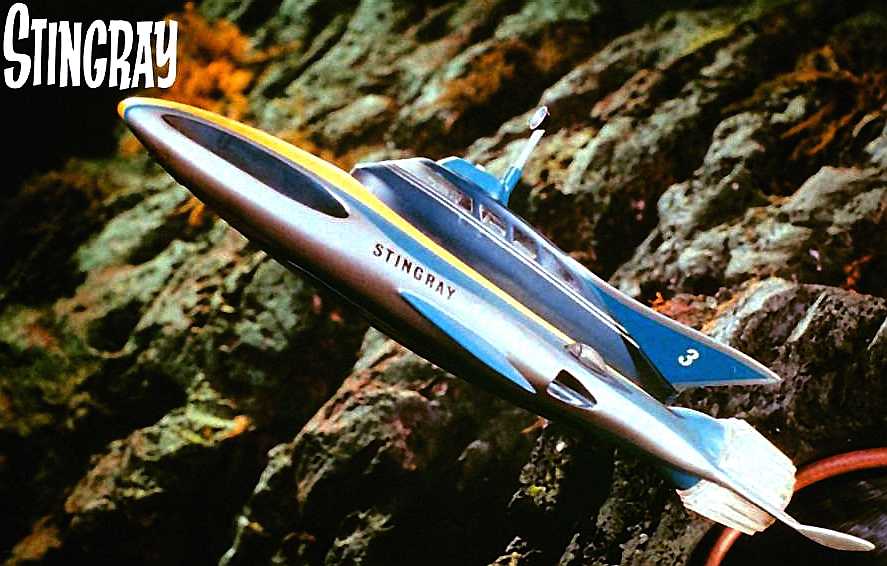
The pilot of Stingray is the square-jawed Captain Troy Tempest (whose Supermarionation puppet was modelled on actor James Garner). He is paired with Dixie navigator Lieutenant George Lee "Phones" Sheridan, nicknamed "Phones" for his role as Stingray's hydrophone operator. (Phones' real name, George Sheridan, is referred to in the series' publicity material but is not mentioned on-screen.) Troy and Phones board Stingray by sitting down in twin command chairs in Marineville's stand-by lounge, which are lowered rapidly into the
submarine via tubular poles. They answer to the crusty, "hoverchair"-bound Commander Samuel Shore, whose daughter, Lieutenant Atlanta Shore, is enamoured of Troy. The reason for Shore's disability is revealed in the episode "The Ghost of the Sea": as a security agent for a deep-sea mining platform, he was injured when a hostile submersible attacked the facility and damaged his patrol craft. He managed to ram the enemy in return, and then escape to the surface, but in so doing lost the use of his legs. Sub-Lieutenant John Fisher also regularly takes shifts in the Marineville control room.
During the course of the series, Stingray encounters a number of undersea races, both hostile and otherwise. The Aquaphibians, an aquatic warrior race, appear regularly—usually under the command of King Titan (modelled on Laurence Olivier), who is the tyrannical ruler of the underwater city of Titanica. In the pilot episode, Stingray is attacked by Titan's forces and Troy and Phones are captured. They are rescued by Titan's slave girl,
Marina (modelled on Brigitte
Bardot), a mute young woman who can breathe underwater. Troy immediately becomes infatuated with Marina, causing Atlanta to become jealous. Titan, meanwhile, swears revenge for Marina's betrayal. Marina becomes a regular member of Stingray's crew, and later acquires a pet seal pup named Oink, who appears in a number of episodes.
Many later episodes revolve around Titan's schemes to destroy Stingray and Marineville. These often fail due to the incompetence of his spy on land, Surface Agent X-Two-Zero (whose likeness is modelled on Claude Rains but whose voice is imitative of Peter
Lorre). Most of the characters, vehicles and places featured the series have names that are connected, in some manner, with the sea. Character names of this type include
Tempest (synonymous with "storm"), Shore, Atlanta (from "Atlantic"), Marina, Lieutenant Fisher and the hostile Aquaphibians. Place names inspired by the sea or its elements include Marineville and Aquatraz, Titanica's prison. Vehicle names include Stingray itself and Titan's lethal submersibles, the mechanical fish, named "Terror Fish" in merchandise and comics but never in the series itself (where they are only referred to as "mechanical fish").
According to the audio adventure Journey to Marineville, the "3" on Stingray's fins indicates that the vessel is Stingray Mark III. Marineville is stated to be 20 miles inland, as opposed to the 10
miles mentioned in the TV episode "The Big Gun".
STINGRAY
CLASS According to the Stingray comic strip in the weekly Countdown comic, more than one Stingray-class submarine was in service in the Marineville fleet. These vessels had names such as Spearfish, Barracuda, Moray and Thornback and were identified by different numbers on their fins, suggesting that the "3" painted on Stingray's tail fin did not indicate that the submarine was a "Mark III" after all.
A similar idea had been adopted by author John Theydon for his second Stingray tie-in novel, Stingray and the Monster, some years prior. In the novel, another WASP
submarine (unnamed and referred to as "Number Thirteen") is hi-jacked by an old enemy of Commander Shore. Theydon's description of the hi-jacked boat, both inside and out, is recognisably similar to that of Stingray, with the exception that "Number Thirteen" is stated not to possess Stingray's exceptional performance, being limited to roughly 400 knots (740 km/h) instead of the 600 knots (1,100 km/h) that Stingray is quoted as being able to attain. The implication, not explicitly stated, is that Stingray is an upgraded version of the design. Later, TV21 comic mentioned a second "super-sub" due to enter service under the WASP that is stolen by a Mysteron agent as part of the plot of a Captain Scarlet and the Mysterons story.
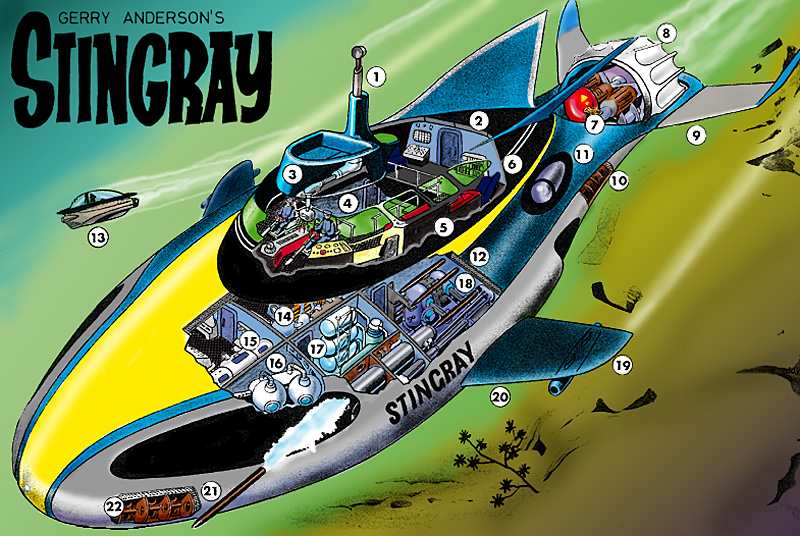
POPULAR FISH:
Please
use the Index below to navigate the Animal Kingdom:-
|
AMPHIBIANS |
Such
as frogs (class: Amphibia) |
|
ANNELIDS |
As
in Earthworms (phyla: Annelida) |
|
ANTHROPOLOGY |
Neanderthals,
Homo Erectus (Extinct) |
|
ARACHNIDS |
Spiders
(class: Arachnida) |
|
BIRDS
|
Such
as Eagles, Albatross
(class: Aves) |
|
CETACEANS
|
such
as Whales
& Dolphins
( order:Cetacea) |
|
CRUSTACEANS |
such
as crabs (subphyla: Crustacea) |
|
DINOSAURS
|
Tyranosaurus
Rex,
Brontosaurus (Extinct) |
|
ECHINODERMS |
As
in Starfish (phyla: Echinodermata) |
|
FISH
|
Sharks,
Tuna (group: Pisces) |
|
HUMANS
-
MAN |
Homo
Sapiens THE
BRAIN |
|
INSECTS |
Ants,
(subphyla: Uniramia class: Insecta) |
|
LIFE
ON EARTH
|
Which
includes PLANTS
non- animal life |
|
MAMMALS
|
Warm
blooded animals (class: Mammalia) |
|
MARSUPIALS |
Such
as Kangaroos
(order: Marsupialia) |
|
MOLLUSKS |
Such
as octopus (phyla: Mollusca) |
|
PLANTS |
Trees
- |
|
PRIMATES |
Gorillas,
Chimpanzees
(order: Primates) |
|
REPTILES |
As
in Crocodiles,
Snakes (class: Reptilia) |
|
RODENTS |
such
as Rats, Mice (order: Rodentia) |
|
SIMPLE
LIFE FORMS
|
As
in Amoeba, plankton (phyla: protozoa) |
|
|
LINKS
http://en.wikipedia.org/wiki/Stingray_(TV_series)
http://en.wikipedia.org/wiki/Stingray
http://en.wikipedia.org/wiki/Piranha
http://en.wikipedia.org/wiki/Flying_fish
http://en.wikipedia.org/wiki/Barracuda
https://en.wikipedia.org/wiki/Manta_ray
http://en.wikipedia.org/wiki/Bluefish
http://en.wikipedia.org/wiki/Tuna
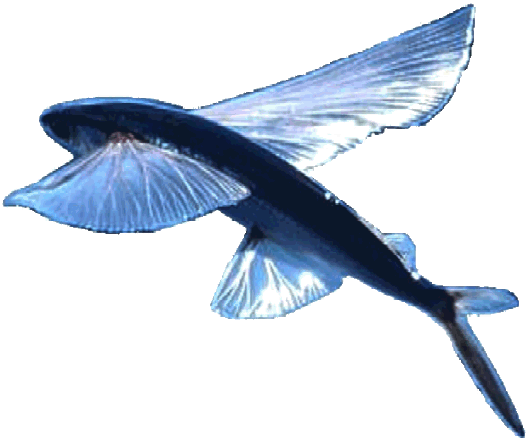
|




